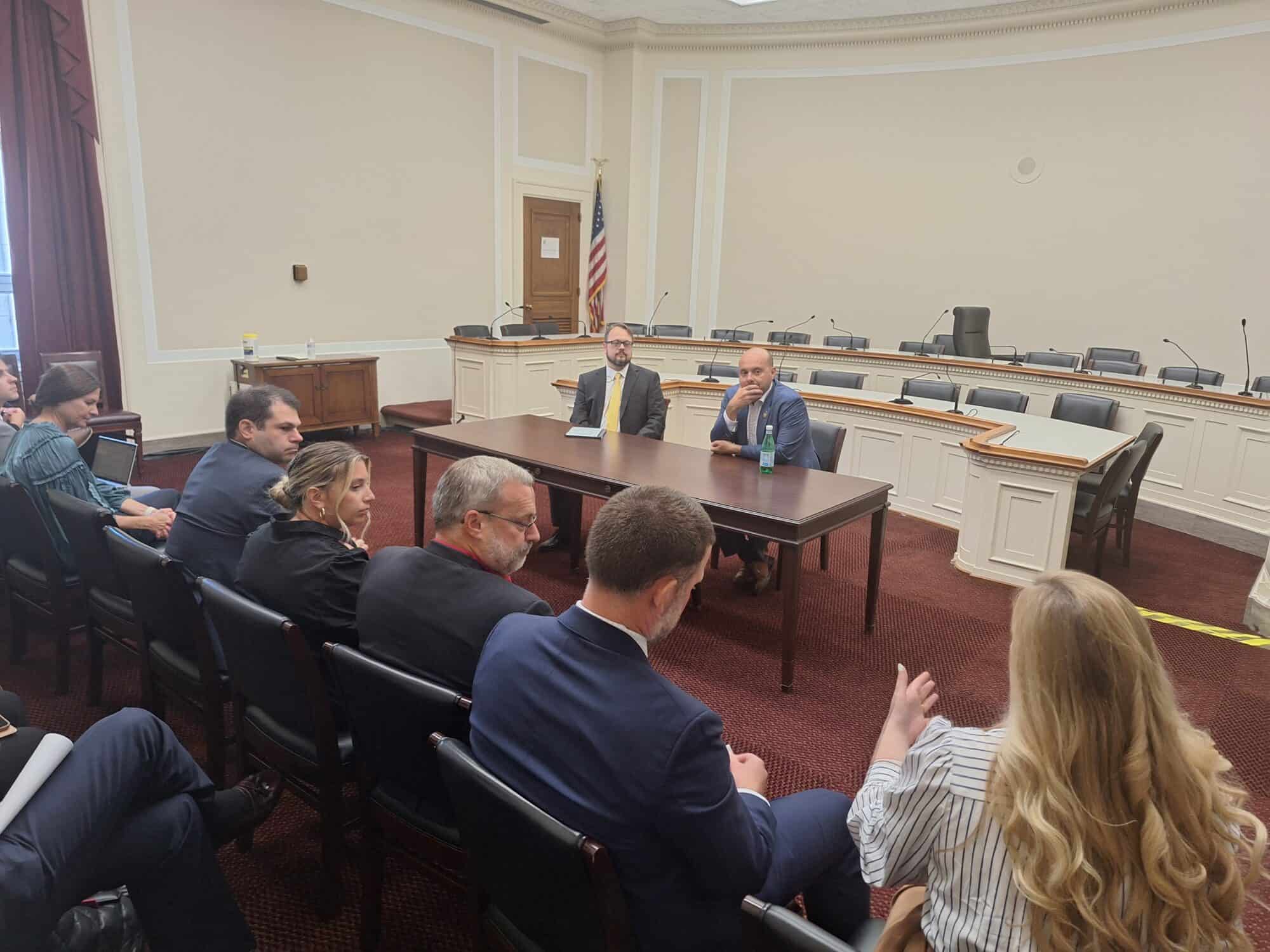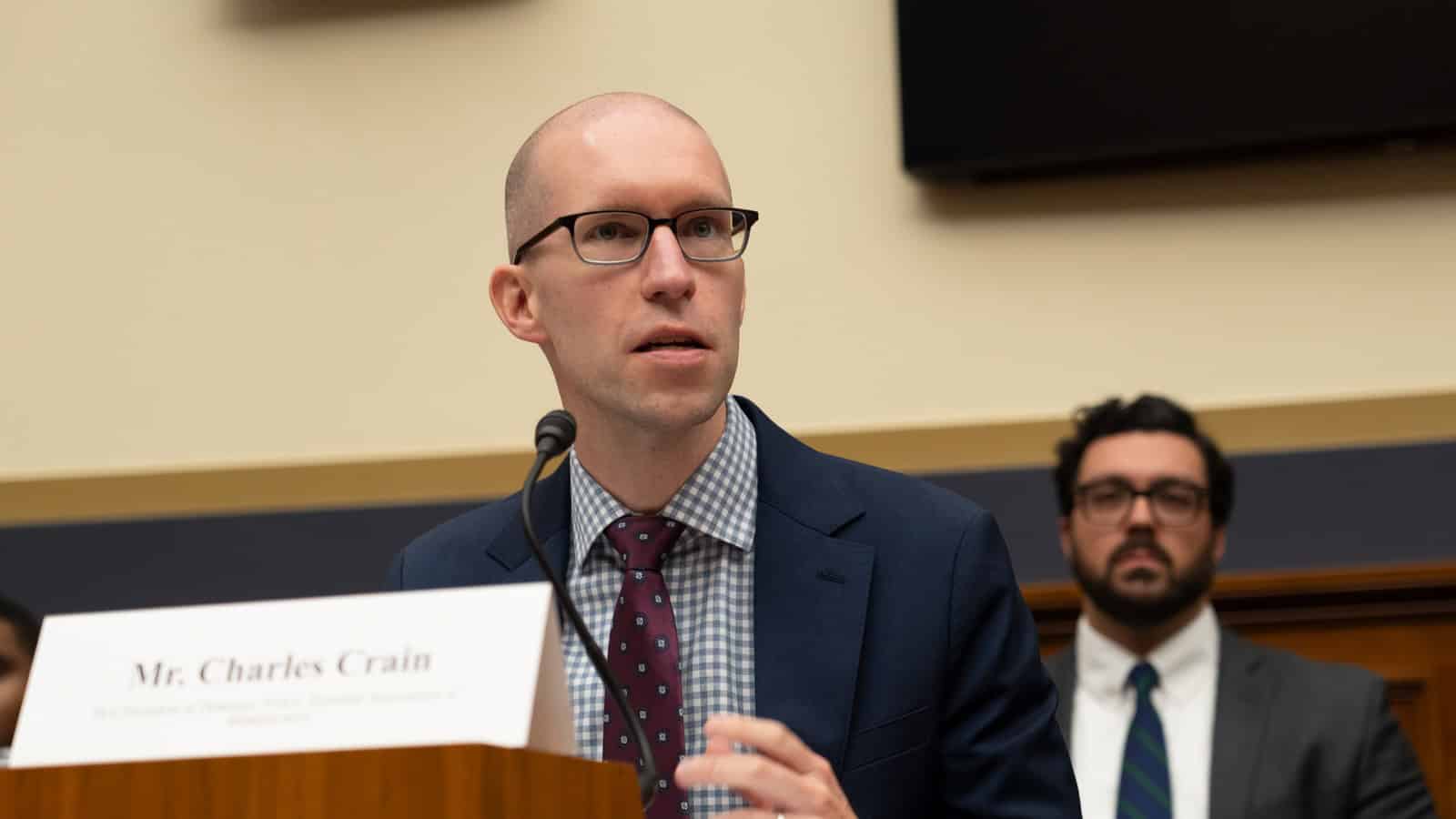NAM-Supported Bills Clear House Committee

The NAM this week advocated the passage of two pieces of manufacturing-critical legislation, successfully driving the agenda of a Wednesday House Energy and Commerce Committee markup.
What’s going on: The committee—with the NAM’s strong support—approved two bills that address longstanding manufacturing priorities:
- A congressional resolution disapproving of the Environmental Protection Agency’s harmful PM2.5 rule
- A bill instituting important pharmacy benefit manager reforms
Reversing an unworkable PM2.5 standard: The EPA announced a new, more restrictive particulate matter standard in February, reducing allowable levels from 12 micrograms per cubic meter of air to 9 micrograms—despite a standard of 9 being “essentially background levels in some of the country,” as the NAM has pointed out.
- “Manufacturers have sharply reduced particulate matter emissions, or PM2.5; as a result, industry in the United States has some of the cleanest and most efficient operations in the world,” NAM Vice President of Domestic Policy Chris Phalen told the committee.
- “Now, the vast majority of emissions are from sources well outside of our control, with fires, dirt roads and other nonpoint sources accounting for 84% of PM2.5 emissions,” Phalen continued. “[T]he EPA’s rule will make it more difficult for states to issue permits for the construction of new facilities or expansions of existing factories.”
- The committee’s PM2.5 resolution, offered under the Congressional Review Act, seeks to overturn the EPA’s unworkable standard.
Reforming PBMs: PBMs are unregulated middlemen whose business practices drive up health care costs for manufacturers and manufacturing workers.
- “By applying upward pressure to list prices that dictate what patients pay at the pharmacy counter, pocketing manufacturer rebates and failing to provide an appropriate level of transparency about their business practices, PBMs increase health care costs at the expense of all patients in America,” NAM Vice President of Domestic Policy Charles Crain said.
- Provisions in the NAM-supported Telehealth Modernization Act would increase transparency into PBMs’ business practices and delink their compensation from medicines’ list prices.
The last word: “Manufacturers commend the Energy and Commerce Committee for approving these important bills, which will reduce costs and enhance growth at manufacturers across the country—allowing our industry to continue to create jobs here at home and drive U.S. competitiveness on the world stage,” said NAM Managing Vice President of Policy Chris Netram.
NAM: Lower Costs Through PBM Reform, Not Price Controls

To lower drug prices, Congress should undertake comprehensive reform of pharmacy benefit managers, not embrace price controls, the NAM told the Senate Tuesday.
What’s going on: “Biopharmaceutical manufacturers are a critical part of the manufacturing economy,” NAM Vice President of Domestic Policy Charles Crain said ahead of a Senate Finance Committee hearing on health care costs.
- In 2021, biopharmaceutical firms “accounted for $355 billion in value-added output to the U.S. economy … and directly employed 291,000 workers in the United States, with each of these jobs supporting an additional 4.1 jobs.”
- Crucially, biopharma companies are also responsible for the dozens of groundbreaking, lifesaving medications brought to patients annually.
- But their continued innovation and economic impact are under attack by both Inflation Reduction Act–mandated drug price controls and the largely unchecked actions of PBMs, Crain continued.
Threats to innovation: Instead of benefiting patients, “the IRA pricing mandates announced last month by the Department of Health and Human Services will … limit the capital manufacturers have available to put toward the astronomically high costs of developing a new medicine,” Crain told the committee, adding that the uncertainty introduced by price controls is also likely to dissuade early-stage investment in new treatments.
- Rather than impose further price controls, Congress should address the influence of PBMs, largely unregulated middlemen that “contribute to the skyrocketing cost of health care by applying upward pressure to list prices that dictate what patients pay for medicines at the pharmacy counter, pocketing manufacturer rebates and failing to provide an appropriate level of transparency about their business models.”
PBM reform: To truly lower health care costs, Congress must rein in PBMs, Crain said. The NAM has called on Congress to adopt specific PBM reforms, including:
- Increased transparency into PBMs’ business models;
- Rebate passthrough to ensure that 100% of negotiated savings get passed on to health plan sponsors and employees; and
- Delinking of PBM compensation from medication list prices.
The last word: “Instead of further embracing price controls, it is imperative that Congress act to lower drug prices by reining in PBMs’ problematic business practices and minimizing their ability to further damage the U.S. health care system,” Crain said.
- “All Americans deserve access to high-quality, affordable health care, and PBM reform is an impactful step toward this goal.”
Manufacturers Need 301 Exclusions Process to Compete Globally
De Minimis Rule Risks Throttling U.S. Supply Chains at Ports of Entry
Washington, D.C. – Following the U.S. Trade Representative’s announcement on the continuation of Section 301 tariffs on China and the White House’s announcement on de minimis, National Association of Manufacturers Vice President of International Policy Andrea Durkin released the following statement:
“A trade war never benefits anyone, and this announcement ignores the realities of today’s economy, potentially harming manufacturers’ ability to grow and invest in the U.S. Manufacturers operate in a rapidly shifting global economy, where tariffs have the potential to affect every industry and every product. To stay competitive, manufacturers must have the flexibility to apply for exclusions as market dynamics change. Without this process, companies of all sizes will be crippled by rigid policies that stifle growth and innovation.
“Raising the cost of critical clean energy inputs, without offering a process for exclusions, directly undermines the Biden administration’s goal of boosting clean energy manufacturing in the U.S. Policymakers must ask tough questions: Are we issuing permits for more domestic aluminum smelters and critical minerals refining for energy production applications? Will wafer and battery production be exempt from regulatory hurdles to ensure automotive and high-tech manufacturing is not slowed? The White House also announced today it will propose a rule significantly altering how goods enter our borders under de minimis, subjecting hundreds of millions of additional packages to scrutiny by CBP—which raises the question of how we will ensure that manufacturing supply chains are not disrupted by this massive new burden on the agency charged with protecting our ports of entry.
“These questions all point to one fact—that tariffs often fail to address the underlying problems they’re supposed to solve, while often complicating manufacturers’ efforts to improve the quality of life for everyone. We are asking the administration to implement an exclusion process that fairly accounts for the unintended consequences of tariffs on our industry’s ability to create jobs and reach the 95% of customers around the world.”
-NAM-
The National Association of Manufacturers is the largest manufacturing association in the United States, representing small and large manufacturers in every industrial sector and in all 50 states. Manufacturing employs nearly 13 million men and women, contributes $2.89 trillion to the U.S. economy annually and accounts for 53% of private-sector research and development. The NAM is the powerful voice of the manufacturing community and the leading advocate for a policy agenda that helps manufacturers compete in the global economy and create jobs across the United States. For more information about the NAM or to follow us on Twitter and Facebook, please visit www.nam.org.
Estate Tax: A Q&A with Rep. Randy Feenstra

The NAM recently interviewed Rep. Randy Feenstra (R-IA), the vice chair of the House Ways and Means Committee’s Rural America Tax Team, about the estate tax and why he’s working with colleagues on Capitol Hill to repeal it.
NAM: Rep. Feenstra, Congress is facing a “Tax Armageddon” next year, as crucial provisions from 2017’s Tax Cuts and Jobs Act are set to expire. As a member of the Ways and Means Committee, what is your focus moving into next year’s debate?
Rep. Feenstra: One of those crucial provisions from the Tax Cuts and Jobs Act that is set to expire is the doubling of the estate tax exemption amount, which currently sits at $13.6 million in 2024. After 2025, it will return to half that amount, adjusted for inflation. That change in the Tax Cuts and Jobs Act was another important step toward full repeal of the estate tax, which my Death Tax Repeal Act would do. The bill makes the simple recognition that death should not be a taxable event. When a family is grieving, the federal government sends a multimillion-dollar tax bill as condolences. This is simply wrong.
I’m proud to co-chair the Rural America Tax Team, which has dug into this issue of the “death tax” and the impact it is having on family businesses across the country. As the tax team has spoken to family businesses and estate tax experts from across the country, it’s become increasingly clear that we still have a lot of work to do to provide relief from what can be a devastating setback for multigenerational family businesses. Repealing this tax is going to be one of my top priorities in 2025, and I’m proud to have the support of 170 of my colleagues.
NAM: The estate tax is imposed on family-owned businesses when ownership of the business passes to the next generation following the death of an owner. As you mentioned, the TCJA doubled the exemption threshold, excluding more assets from taxation and thus reducing the burden of the estate tax on businesses. Why is this important and what is Congress doing to preserve this higher threshold?
Rep. Feenstra: Over the years, various bills have taken steps toward providing relief for taxpayers hit by the death tax. The Tax Cuts and Jobs Act was one of the largest expansions of that relief, significantly reducing the number of family businesses hit by the tax and reducing the tax burden for those businesses that still are. People often don’t realize that businesses over many generations can accumulate assets that can put them over the asset threshold, but that doesn’t mean these businesses have a lot of cash on hand. So when they’re hit with millions in new taxes, that can sink an already cash-strapped business. Fortunately, because of the doubling of the exemption amount, far fewer businesses face that threat. As long as any family business does face that threat, we still have work to do.
NAM: At the end of 2025, the estate tax is scheduled to be reduced by half, subjecting more of family-owned manufacturers’ assets to taxation and increasing their estate tax liability. As the Ways and Means Committee and tax teams continue meeting with businesses around the country, what are you hearing on the impact this change would have?
Rep. Feenstra: Two things: A lot more people would be hit by the death tax, and the people who are hit would be paying a much higher tax. These are small family businesses we are talking about, and if the current exemption amount is allowed to return to half its current value, that means the size of the businesses getting hit are much smaller than they are today. People often think of farms, and that’s certainly true, but as you know, manufacturers are hit, family-owned restaurants, auto dealers, you name it. As we go into 2025, we need to be focused on policies that support growth and help these businesses succeed, not create costly obstacles for them to overcome. If the exemption amount falls to its pre–Tax Cuts and Jobs Act level, that’s a lot of new businesses that are going to be hit by this tax.
Rep. Garbarino, NAM Talk CIRCIA Flaws

A draft Department of Homeland Security rule requiring that certain sectors expedite cyber-incident reporting has several shortcomings that must be addressed before the rule becomes final in the fall of 2025, the NAM told Rep. Andrew Garbarino (R-NY) in a meeting this week.
What’s going on: Rep. Garbarino, chair of the House Homeland Security Subcommittee on Cybersecurity and Infrastructure Protection, met with manufacturers and the NAM Technology Policy Committee Tuesday to talk cybersecurity issues.
- Much of the discussion focused on draft rulemaking published in April by the DHS’s Cybersecurity and Infrastructure Security Agency. It would require “covered entities” in “critical infrastructure sector[s]” to report any major cybersecurity incidents to CISA within 72 hours.
- Under the Cybersecurity Incident Reporting for Critical Infrastructure Act, CISA must finalize the rule by October 2025.
Why it’s a problem: The NAM agrees with the concerns Rep. Garbarino raised with CISA, including:
- The burden associated with imposing onerous reporting mandates on companies recovering from cyberattacks;
- An overbroad scope, which forces into compliance both organizations that are not truly “critical infrastructure” and those that are too small to have the resources needed to complete the required actions;
- An overbroad definition of incidents requiring reporting;
- An excessive amount of required information;
- An unreasonably high cost of compliance and the diversion of resources away from cyber-incident response; and
- The risk that the proposed rule will jeopardize CISA’s role as a trusted partner of industry.
NAM in action: The NAM submitted comments in response to CISA’s proposal earlier this year outlining these concerns, as well as calling for a reduction in both the number of entities required to file incident notifications and the number of incidents they have to report.
The NAM says: “CISA needs to significantly rethink its approach to CIRCIA’s implementation,” said NAM Senior Director of Technology Policy Franck Journoud.
- “The proposed rule requires far too much information about far too many incidents from far too many companies. CISA should not mandate that companies under attack from hackers divert precious security resources to generate mountains of incident data that CISA will not have the means to process or act upon.”
Take precautions: If you are looking to strengthen your company’s cyber protections, check out NAM Cyber Cover, an affordable, broad security program for NAM members that provides proactive monitoring with automated alerts at no extra cost.
Curb Proxy Firms, NAM Tells Congress

Less than three months after scoring a significant win for manufacturers against Securities and Exchange Commission overreach, the NAM was back in front of Congress to urge regulatory oversight of proxy advisory firms.
What’s going on: On Tuesday, the NAM testified before the House Financial Services Oversight and Investigations Subcommittee on the need to bring oversight and accountability to proxy advisory firms. These are entities that make recommendations regarding the way shareholders should vote on proxy ballot proposals brought before publicly traded companies.
- “Proxy firms are powerful, unaccountable actors that pose a real threat to Americans’ financial security. Manufacturers have been subject to these firms’ outsized influence for far too long,” NAM Vice President of Domestic Policy Charles Crain said during Tuesday’s hearing.
The background: In 2020, the SEC finalized an NAM-supported rule instituting important proxy reforms, such as requiring proxy firms to disclose any conflicts of interest. The NAM has fought in court to preserve the 2020 rule, successfully defeating the SEC’s attempts to suspend the rule and to rescind its most crucial provisions. The NAM is now back in court in a third case, defending the SEC’s authority to regulate these powerful market actors.
Surrendering to ISS: Institutional Shareholder Services Inc., the largest and most influential proxy advisory firm, is now “suing the SEC over its authority to issue the 2020 rule—not just the rule’s particulars, but the SEC’s ability to regulate proxy firms at all,” Crain continued.
- Troublingly, “the SEC is waving the white flag in the face of [the] challenge,” he told lawmakers, referring to the agency’s decision not to appeal after a district court sided with ISS earlier this year.
“Sole defender”: The NAM—now the “sole defender of the 2020 rule”—is appealing the district court’s decision.
What Congress should do: Legislators must take up the mantle, too, Crain concluded.
- “Congress should do what the SEC will not: affirm the SEC’s clear authority, provide much-needed oversight and accountability and help manufacturers and Main Street investors escape the outsized influence of proxy advisory firms.”
The Estate Tax, Explained

Congress should preserve tax reform’s changes to the estate tax, protecting family-owned manufacturers from tax increases scheduled for the end of 2025, according to a new explainer published by the NAM as part of its “Manufacturing Wins” tax campaign.
The background: In 2017, tax reform doubled the value of assets that could be exempt from the estate tax, a levy imposed on family businesses upon the death of their owners, when proprietorship passes to the next generation.
What’s going on: This valuation threshold is scheduled to be cut in half at the end of 2025, subjecting more assets of family-owned manufacturers to taxation and increasing these companies’ tax liability.
Why it’s important: A bigger tax burden would threaten the continued existence of family-owned companies and make it more difficult to pass family businesses on to the next generation.
- These firms could be forced to liquidate operation-critical assets, such as facilities and equipment, in order to pay the estate tax.
- An increased estate tax bill could mean that family-owned manufacturers are forced to take on debt, limit operations, reduce employee headcount or close entirely following the death of a loved one.
What else is at risk: Some legislators have floated the idea of repealing or limiting stepped-up basis, which stops a business owner’s heirs from being forced to pay capital gains taxes on asset appreciation that took place while the owner was alive.
What must be done: “Congress must preserve tax reform’s increased estate tax exemption threshold and maintain stepped-up basis,” said NAM Vice President of Domestic Policy Charles Crain.
- “Protecting family-owned manufacturers from the estate tax will prevent these small businesses from incurring costly and damaging tax bills that threaten their viability following the death of a loved one.”
NAM to EPA: Reissue Formaldehyde Analysis

The Environmental Protection Agency’s final formaldehyde analysis—issued in August and set to inform future regulations—risks “creat[ing] an unachievable standard and a de facto ban” on an essential manufacturing material, the NAM said.
What’s going on: On Aug. 20, the EPA’s research office issued its conclusions about the “amount of the chemical that could be harmful” to humans, saying that “[s]mall amounts … can increase people’s risk of [health] problems” (Bloomberg Law, subscription).
- Though the report itself does not mandate any new restrictions on the industry, the EPA is likely to use the findings to take the next step in the regulatory process—a final risk evaluation—by the end of 2024 (The Hill).
- The assessment maintains the formaldehyde threshold of 11 parts per billion proposed by the agency in 2022. That’s 30 times lower than Europe’s recently updated worker-exposure limit of 300 parts per billion and “lower than what can be found in homes or even background levels for outdoor air,” the NAM told the EPA.
Why it’s a problem: Formaldehyde is used widely across industries to produce numerous everyday items, including plastics, lubricants, automotive parts, fertilizers, adhesives and more.
- The final analysis, which was released without review by the EPA’s own Science Advisory Committee on Chemicals, fails to account for “the highly developed safety procedures, protocols and [personal protective equipment] used throughout [the manufacturing] industry.”
- A severe restriction on the allowable workplace threshold of formaldehyde “could wreak havoc on domestic supply chains,” according to the NAM.
What should be done: The EPA should reissue its risk evaluation to give the SACC an opportunity to review it and provide comments—“and allow for additional public comment after the SACC review is complete,” the NAM concluded.
NAM Launches Ad Campaign for PBM Reform

The NAM has launched a new wave of ads in D.C. and nine states, extending its seven-figure campaign urging policymakers to reign in pharmacy benefit managers, underregulated middlemen who drive up the costs of prescription medications for manufacturers and manufacturing workers.
A quick refresher: PBMs sit in the middle of the health care industry, negotiating with employer health plans, insurers, biopharmaceutical manufacturers, pharmacies and other players to determine what prescriptions employees can access and what they pay for them. While their job is ostensibly to reduce the costs of medicines, often they do the exact opposite.
- PBMs have been found to steer patients toward pricier options, inflict steep mark-ups and hidden fees and even pocket large portions of the rebates that biopharmaceutical manufacturers intend for American workers and their families.
NAM in action: The NAM has been a staunch voice supporting PBM reform on Capitol Hill, recently laying out manufacturers’ concerns for the House Committee on Oversight and Accountability.
- The committee conducted its third hearing on PBM overreach in July, when it also released a highly critical report on PBMs that echoed many of the NAM’s concerns.
- In addition, the NAM is supporting several key measures to increase oversight of PBMs’ business models and reform their pricing strategies, including the DRUG Act and the PBM transparency provisions in the Lower Costs, More Transparency Act.
What Congress should do: The NAM is advocating for three major reforms to the PBM system, including:
- Increasing transparency in PBMs’ business models, including how their compensation influences health care decisions and how their policies dictate a medicine’s cost and formulary placement;
- Rebate pass-through, which will ensure health care savings are passed directly to manufacturers and their workers rather than being pocketed by PBMs; and
- Delinking PBMs’ compensation from a medicine’s list price, removing their incentive to put upward pressure on list prices to maximize their own profits.
Benefits for all: The NAM is calling on Congress to enact these reforms in the commercial insurance market, not just in government programs like Medicare and Medicaid, so that all Americans can enjoy lower-cost health care benefits.
What to watch: The NAM is calling on Congress to act on this issue during the lame-duck session following the election.
Manufacturers: EPA’s PFAS Reporting Delay Underscores Massive Administrative Burden
Washington, D.C. – Following the Environmental Protection Agency’s decision to delay the deadline for when companies must submit records dating back to 2011 on per- and polyfluoroalkyl substances, otherwise known as PFAS, National Association of Manufacturers Vice President of Domestic Policy Chris Phalen released the following statement:
“We are pleased to see the EPA delay this retroactive reporting requirement—as the NAM has called for—which will temporarily prevent an increase in the regulatory burden facing manufacturers. More broadly, today’s announcement reflects the massive administrative burden this proposal would impose on both the business community and regulators, while failing to provide insights for effective and prioritized public health efforts. We urge the agency to reverse course entirely, unless and until it has the capacity to effectively enforce the standard.”
-NAM-
The National Association of Manufacturers is the largest manufacturing association in the United States, representing small and large manufacturers in every industrial sector and in all 50 states. Manufacturing employs nearly 13 million men and women, contributes $2.87 trillion to the U.S. economy annually and accounts for 53% of private-sector research and development. The NAM is the powerful voice of the manufacturing community and the leading advocate for a policy agenda that helps manufacturers compete in the global economy and create jobs across the United States. For more information about the NAM or to follow us on Twitter and Facebook, please visit www.nam.org.
